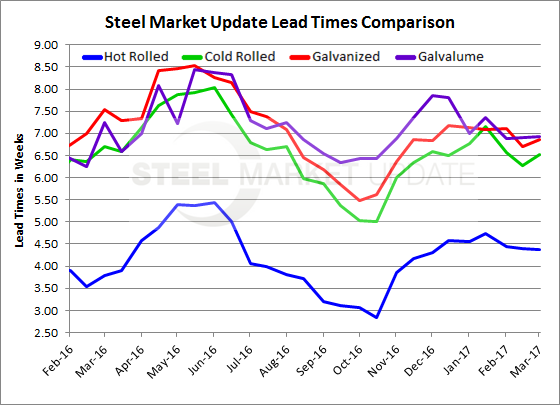SMU Data and Models

Steel Mill Lead Times: Essentially Unchanged from 2 Weeks Ago
Written by John Packard
March 9, 2017
Hot rolled average lead times remain extended at 4.38 weeks compared to the 3.79 weeks SMU was reporting one year ago. Cold rolled, galvanized and Galvalume lead times were running close to or just below last year’s reported average.
Lead time is the average amount of time it takes for a new order of a product to be produced at a domestic steel mill. The lead time averages are based on the collective responses to our early March flat rolled steel survey made by manufacturers and service centers. The average lead time is not tied to any one mill and can vary so buyers need to be aware of the exact lead times being quoted on all products at each of the domestic mills by contacting their mill representative.
Hot rolled lead times continue to be slightly extended at almost 4.5 weeks. As mentioned at the beginning of this article the lead time average produced today is one half a week longer than what we reported one year ago.
Cold rolled lead times are averaging 6.5 weeks (6.53 weeks) and are just under the 6.71 weeks reported one year ago.
Galvanized lead times are just under 7 weeks (6.83 weeks) which is approximately one half a week shorter than one year ago.
Galvalume lead times were also just under 7 weeks (6.93 weeks) which is about one quarter a week shorter than one year ago.
A side note: The data for both lead times and negotiations comes from only service center and manufacturer respondents. We do not include commentary from the steel mills, trading companies, or toll processors in this particular group of questions.
To see an interactive history of our Steel Mill Negotiations data, visit our website here.

John Packard
Read more from John PackardLatest in SMU Data and Models

SMU Scrap Survey: Sentiment Indices rise
Both current and future scrap sentiment jumped this month, though survey participants reported responses before key trade news was announced.

SMU Survey: Sentiment splits, buyers have better view of future than the present
SMU’s Steel Buyers’ Sentiment Indices moved in opposite directions this week. After rebounding from a near five-year low in late June, Current Sentiment slipped again. At the same time, Future Sentiment climbed to a four-month high. Both indices continue to show optimism among buyers about their company’s chances for success, but suggest there is less confidence in that optimism than earlier in the year.

SMU scrap market survey results now available
SMU’s ferrous scrap market survey results are now available on our website to all premium members. After logging in at steelmarketupdate.com, visit the pricing and analysis tab and look under the “survey results” section for “ferrous scrap survey” results. Past scrap survey results are also available under that selection. If you need help accessing the survey results […]

SMU flat-rolled market survey results now available
SMU’s latest steel buyers market survey results are now available on our website to all premium members. After logging in at steelmarketupdate.com, visit the pricing and analysis tab and look under the “survey results” section for “latest survey results.” Past survey results are also available under that selection. If you need help accessing the survey results, or if […]

SMU Survey: Sheet lead times stabilize, plate contracts
Mill lead times for sheet products were steady to slightly longer this week compared to our late June market check, while plate lead times contracted, according to steel buyers responding to this week’s market survey.

